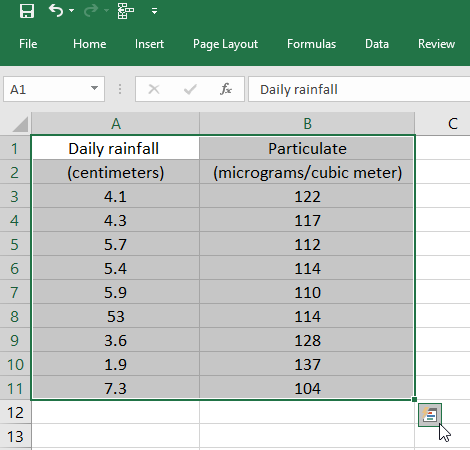

- #HOW TO DO STATISTICAL ANALYSIS IN EXCEL 2013 FULL#
- #HOW TO DO STATISTICAL ANALYSIS IN EXCEL 2013 CODE#
- #HOW TO DO STATISTICAL ANALYSIS IN EXCEL 2013 FREE#

The simplest technique is using AVERAGEX, iterating a table of the desired granularity and calculating for each iteration the expression that generates the single data point to use in the average. You can use many DAX techniques to implement this calculation.
#HOW TO DO STATISTICAL ANALYSIS IN EXCEL 2013 FULL#
The moving average is a calculation to analyze data points by creating a series of averages of different subsets of the full data set. AVERAGEX: calculate the average on an expression evaluated over a table.AVERAGEA: returns the average of all the numbers in a column, handling both text and non-numeric values (non-numeric and empty text values count as 0).AVERAGE: returns the average of all the numbers in a numeric column.You can use standard DAX functions to calculate the mean (arithmetic average) of a set of values. The formulas in this pattern are the solutions to specific statistical calculations. We would like to thank Colin Banfield, Gerard Brueckl, and Javier Guillén, whose blogs inspired some of the following patterns. The Statistical Patterns are a collection of common statistical calculations: median, mode, moving average, percentile, and quartile. Excel, from this point of view, has a much richer language.

Other typical statistical calculations require you to write longer DAX expressions.
#HOW TO DO STATISTICAL ANALYSIS IN EXCEL 2013 CODE#
If you use Excel 2010 or Excel 2013, most of the DAX statistical functions are not available and you can rely on an alternative implementation based on DAX code as described in this page.ĭAX includes a few statistical aggregation functions, such as average, variance, and standard deviation. Just select your data, click on QI Macros and then Stat Wizard.If you use Power BI, Analysis Services, or Excel 2016 or later versions, you can use the statistical functions in DAX. QI Macros Stat Wizard will analyze your data and choose the right hypothesis tests for you. Interactive Results: QI Macros lets you change the significance level to see what impact those changes have on your results. Interprets the results for you: QI Macros will compare the p-value to the significance level (0.05) and indicate that you "Cannot Reject the Null Hypothesis (Accept the Null Hypothesis) because p<0.05" and that the "Means are Different."ĭraws a chart to help you visualize the results: QI Macros ANOVA test results include a box plot which helps you see the difference in means (color change line in the box) and the variation (height of the box and length of the whiskers.)

What's Cool about the ANOVA Tool in QI Macros Software? 05) and run the Analysis of Variance Calculations for you: QI Macros will prompt you for the significance level (default is.Next click on QI Macros menu and select Statistical Tools then the ANOVA test you want:.Just click and drag over your data to select it:.QI Macros for Excel Makes ANOVA as Easy as 1-2-3 Tried to learn another more complicated statistics program?.Have you struggled with the awkward interface of Excel's Data Analysis Toolpak?.Does the thought of performing complicated statistical analysis intimidate you?.Statistical Analysis Excel » ANOVA in Excel Analysis of Variance - ANOVA in Excel You Don't Have to be a Statistician to Do ANOVA
#HOW TO DO STATISTICAL ANALYSIS IN EXCEL 2013 FREE#


 0 kommentar(er)
0 kommentar(er)
